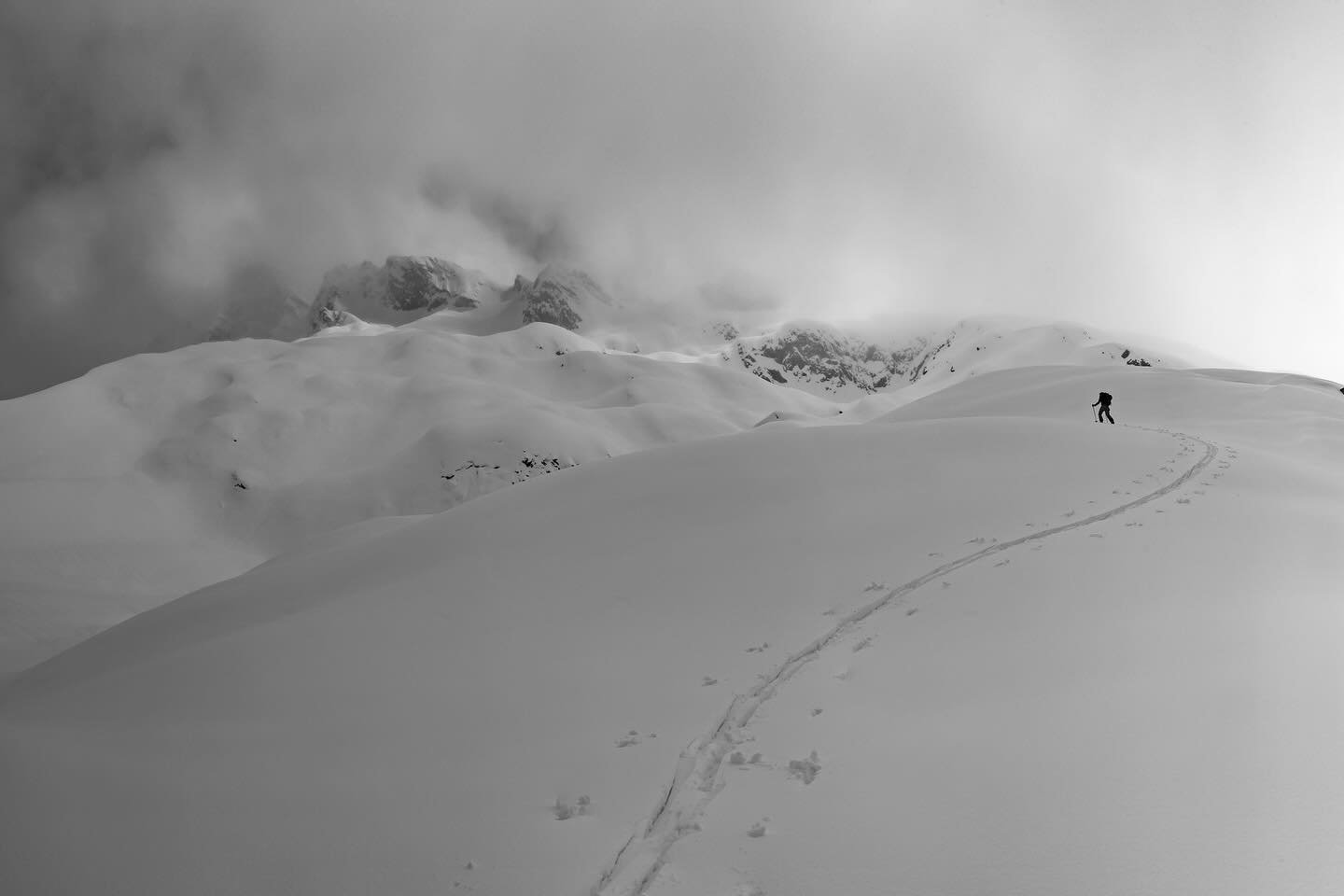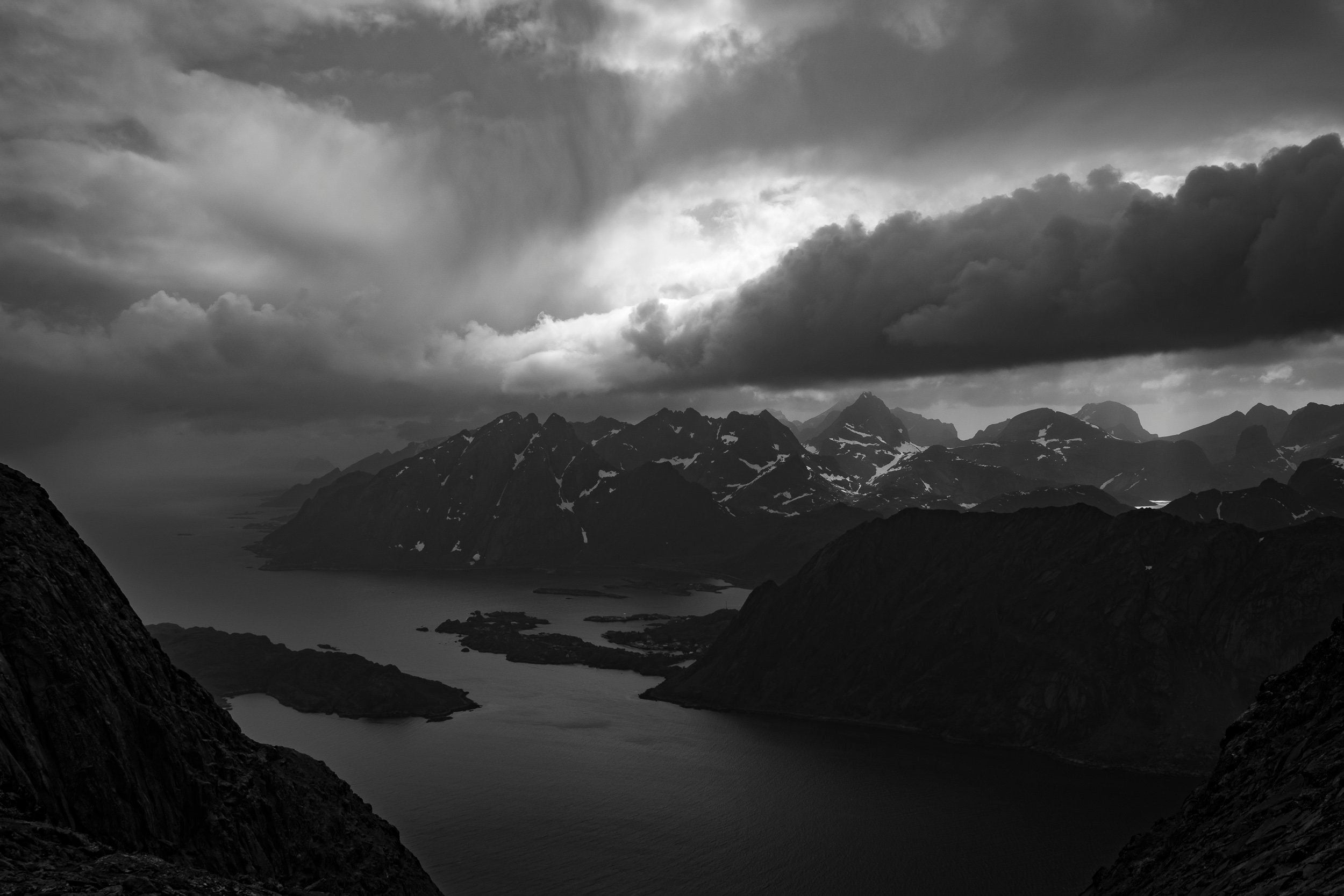The backcountry skiing terrain in the Snoqualmie Mountains is complex and dynamic. There are few routes that are welcoming for beginners, and many routes that require special conditions to be experienced optimally. Then there are a handful of routes that lie just inside the border of the impossible. Routes like the NE Buttress and North Face of Chair Peak, the North Face of Lundin, and the North Face of Bryant have only seen a very small handful of complete ski descents. Students of the zone, like myself, watch closely as year-after-year, these rare beasts perhaps come into fleeting form for a few hours at a time, or more often, do not. With many of the low-likelihood lines in the area, I’ve got a plan for how I’d ski them, but I’m totally content with the knowledge that many may go unvisited by yours truly. I’ll wait as long as it takes for everything to line up, and know that in some cases, it never will. Some of the joy is in just imagining wild adventures.
High on my list of dream lines for over a decade has been a continuous line to the north off of Melakwa Point, a sub-summit of Chair Peak that sees infrequent ski descents to the west, but which offers a whole different experience to the north, including a wild couloir that has danced through my dreams for years. The route is challenging on many levels, requiring some proper mountaineering chops just to gain the summit of the peak, and from there, things only get more complex as a series of cruxes, each with their own unique challenges, stack like a tower of Jenga blocks. For the full report, read on. If you wanna skip to the video, just rip on down to the bottom of the post and enjoy!
On May 8th, 2024, I decided to go peek at the mountains, just to see what was there for the enjoyment. The previous day, a group of friends had come back with reports of 6-10” of excellent powder in the Slot Couloir of Snoqualmie Mountain. This was on top of a series of small storms over the course of the previous week which had been unseasonably cool and showery. Underneath this new snow was a consolidated snowpack that had already adjusted to multiple spring warmups and could be considered locked-up, at least until the next major warming event. Said event was scheduled to start around midday on the 8th, so Andrew Eckels and I got an early start with hopes of finding the last fix of excellent, cold snow before spring returned with abandon.
As we climbed up above Source Lake en route to the Chair Peak notch, we were struck with the robustness, and the ‘pastiness’ of the snowpack in the upper reaches of the zone. Lines that had been fully melted out weeks ago were magically plastered with a fresh coat of snow and looked to be in excellent form. Logging this information, we skinned easily all the way to the notch before transitioning for a descent to Snow Lake via the steep slopes skiers right of the standard north slopes route. I expected decent snow. What we found could only be described as excellent. Smooth, fast, stable powder. Plastered on. What witchcraft is this? Could this be one of those really special days???
Looking around from our vantage on Snow Lake, we continued to be greeted with signs of excellent conditions and shockingly good coverage. At this point, my imagination went into overdrive. What if it was a day to try something really rare? What if the most enduring puzzle of the zone was ripe to be unlocked? I scoped the north ridge of Melakwa Point with my long lens and found that the critical keyhole off of the ridge was feasible. Not completely covered, put perhaps a good ol’ fashioned Alpental finagle would get us through the crux. I could see a way to get from the summit down and off of the north ridge, but the biggest question still remained. Would the unlikely couloir that came next actually be possible? We’d have to start climbing the slopes below Roosevelt to get a view and find out for sure.
We took a broad roundabout approach to Chair Peak lake in order to get the best vantages possible of the couloir. To our delight, where often one finds near vertical slabs of rock and blue ice, there was a very convincing ribbon of snow. From one point, the entrance looked reasonable but the lower half appeared to choke down to nothing, yet from another perspective, the good entrance was hidden from view, but the bottom half looked reassuringly fat. Having studied this line for years and years, I had a good mind for what I would need to see in order to make an attempt. On this beautiful May morning, I was seeing exactly what I had dreamed. That miracle of the maritime snowpack in spring. Snow plastered to faces where it has no business being. Where colder, dryer snow sheds off on contact, but Cascade concrete builds. Just enough new snow, at just the right temperature, with just a kiss of sun. Perfect.
Convinced that it was worth a try, we continued the climb to Chair Peak Lake and Melakwa Pass beyond. The direct west face of Melakwa Point looked feasible for climbing, but some shallow wind slab potential convinced us to turn the corner beyond the pass to attempt a notch on the SW side of the peak. The climbing went from stable and secure to a thin veneer of dry snow on top of featureless rock slabs. Fortunately, the ubiquitous subalpine trees gave us hand and footholds where the rock left us scratching desperately, and soon we were on the west ridge proper, where a quick boot-pack delivered us to the summit.

Melakwa Point is the snowy dome in the center of this image. The north ridge is the prominent rock ridge connecting the peak down to the west side of Snow Lake. The couloir in question is a the end of the ridge.
The line starts casually enough, as a broad 45 degree slope delivers you to a rambling low angle ridgeline, this ridgeline, while casual in slope-angle, becomes a vertiginous tightrope as it gradually narrows into a blind rollover, and the huge cliffs to the right and left become more and more apparent in one’s consciousness. An unintended exit in either direction would spell certain disaster, so stable snow with perfect traction is an imperative. Just as the walls appear to have closed in on all sides, an exit reveals itself in the form of a small weakness in the ridge to the east. Coverage here is often dubious, and on the day in question, I was able to hop over a short rock band, then cross a fluted feature to gain the east facing bowl below Melakwa’s north ridge. The bowl was suffering from the effects of the morning sun, so the snow was already getting hot and sensitive, but the depth of the new snow was reasonable and the traverse was quickly dispatched as the obvious funnel broke to the north of the main face.
The couloir starts simply enough, but it turns a corner and steepens out of sight, so one must commit quite a ways before the entire line is revealed. Cautious turns continued to yield positive results as good snow was found across the breadth of the feature, only firming up moderately for the last handful of turns. At any point, it could have ripped off its friendly mask and revealed a dreadful face of thinly covered ice or rock, but the perfect ingredients proved true to their potential, leaving just one final crux.
The couloir exits to a steep hourglass which funnels to a mandatory cliff. While I can envision a world where even better conditions are found and a person can ski the direct exit with an enjoyable high speed cliff drop to glory, in this instance, we have reached the time of year when the lower parts of the mountain have melted out substantially, leaving a larger than ideal cliff, while the landing area below is filled with heavily compacted avalanche debris. Best avoided. A critical high traverse would unlock the exit. Unfortunately, this E/NE facing slope had been cooking in the morning sun, so it was primed to start shedding. Fortunately, we were just early enough, and the snow was just shallow enough, that it was content to let us pass without unleashing any legitimate volume.
Breaking over the gap in the ridge, we were rewarded with yet another handful of powder turns before committing to the final exit slopes and the sticky, manky snow that lurked on the low angle fan at the base of the face. I can genuinely say that there were a couple of bad turns at that point. I’m not mad about it. I’m not mad at all.
It’s been suggested that this may be a first descent. I’d be gratified to find this so. I’d also be honored to learn of the adventurous people who have skied it before us, should that be the case. Please reach out with pertinent info in this regard. In the interim, I’ve opted to give this feature a name so that we don’t have to refer to it as “That tight couloir down off of the north ridge of Melakwa Point, but not Little Alien, the one further to the looker’s left that goes down to Snow Lake.” In Chinook Jargon, Melakwa means mosquito. This being the skinny, sharp pointy feature at the business end of Melakwa Point, I figure Proboscis Couloir is a fitting name.
Big thanks to my partner, Andrew Eckles (@snow_troopers) for being game to get weird, and for always keeping the stoke high, and to all of my partners and collaborators with whom I’ve mind-skied this line in the lead up to the actual event. Thanks for reading. Comments are always appreciated.





Leave a comment
This site is protected by hCaptcha and the hCaptcha Privacy Policy and Terms of Service apply.